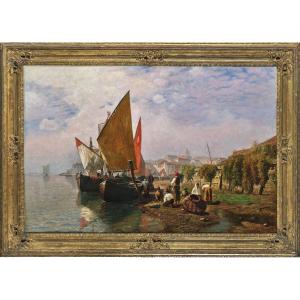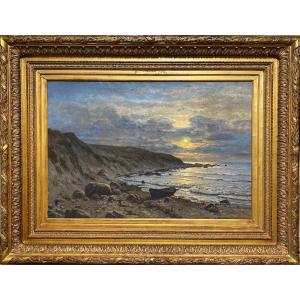Driving the Harnessed Cart
Material: Oil on canvas
Dimension: 39 x 49 cm
Frame: Yes
About the Artist:
Philogene Charles Tschaggeny (Brussels, May 26, 1815 - Saint-Josse-ten-Node, June 12, 1894) is a Belgian painter of genre scenes, animals and ships who adheres to romanticism.
He is the son of Frédéric Guillaume, originally from Neuchâtel (Switzerland), and Céline, Baroness de Charvet, originally from Lorraine. His brother Edmond Tschaggeny was also a painter. Charles Tschaggeny married the Frenchwoman Céline Bonduel and had three children: Frédéric, Léonie and Ernest. He first lived (around 1852) at 27 bis rue de la Couronne, then (around 1881) at 1 rue de l'Overvloed in Brussels. Charles Tschaggeny was first employed at the Ministry of Finance in Brussels. At the same time, he developed his artistic talent as a student of Eugène Verboeckhoven (1799-1881), an animal painter already world-famous at the time. Eugène Verboeckhoven and Charles Tschaggeny often worked together on the same painting, both at the time and later. Like Verboeckhoven, Charles Tschaggeny devoted himself to animal painting. In 1836, he resigned from the ministry to devote himself entirely to painting. In 1839, he stayed in Antwerp, where he perfected his art under the direction of Nicaise De Keyser (1813-1887) and Hendrik Leys (1815-1869). By 1840, Tschaggeny's reputation as a specialist in horse painting was already established, as that year he received a commission to paint the horses of the Belgian state stud farm.
In 1842, William II, King of the Netherlands, commissioned from him the portrait of the horse he had ridden at the Battle of Waterloo and, in 1844, Leopold I commissioned the portrait of the horse he had ridden during his accession to the throne. Much later, in 1882, Tschaggeny painted horse portraits for Queen Maria-Hendrika, herself an experienced rider; Tschaggeny was also part of his close circle of friends. Queen Victoria of England was also a great admirer of Tschaggeny's painting. In 1842, Tschaggeny obtained his first medal at the Brussels Salon. In 1845, his Peasant at Rest earned him a gold medal. Leopold I bought the painting for his collection. Tschaggeny achieved another great success with his Horse Market (Salon 1846, Antwerp). In the years 1848-1849, Tschaggeny stayed in London, Oxford and Cambridge. From 1848 dates A Battlefield (formerly in the JM Oppenheim collection, now in the National Gallery in London), a work with very romantic overtones. In 1851, Queen Victoria purchased the Harvest painting for her collection. Charles Tschaggeny is a bourgeois and very commercial artist. Its sales channels are national and international fairs and established art dealers of the time. He became a member of the Royal Academy in 1865.

































 Le Magazine de PROANTIC
Le Magazine de PROANTIC TRÉSORS Magazine
TRÉSORS Magazine Rivista Artiquariato
Rivista Artiquariato